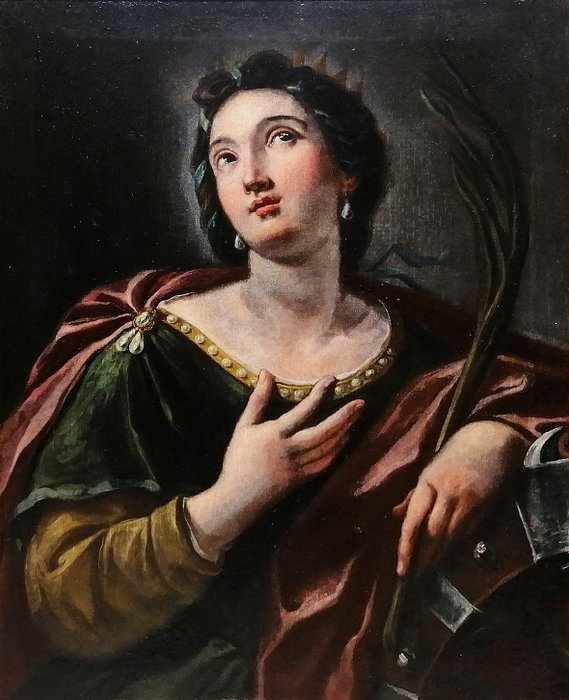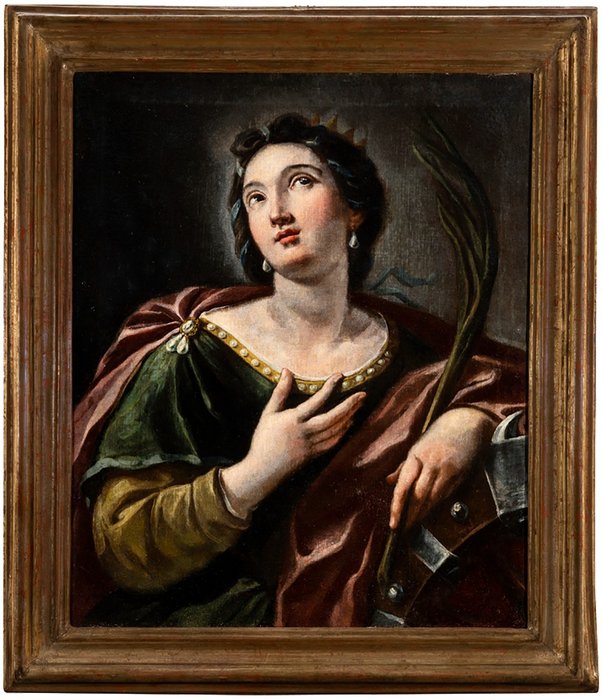Advert Description
Are you interested in this item? This item is up for auction at Catawiki. Please click on "respond to advert" (orange button) to get redirected to the Catawiki website. Catawiki’s goal is to make special objects universally available. Our weekly auctions feature thousands of unusual, rare, and exceptional objects you won’t find in just any store. FLEMISH DIONYSUS [attributed to]
o Denys Calvaert (Aversa, 1540c. – Bologna, 1616)
Saint Catherine of Alexandria
Oil on canvas, 67 x 55.5 cm
Frame size, cm. 82 x 71 x 6 approx
NOTES: Publication of the catalog of works from the Intermidiart collection. Certificate of Guarantee and Lawful Origin. Work with antique frame (?) Salvator Rosa gilded (defects):
Interesting old painting, bought on the antiques market and initially referred to the school of Guido Reni. The painting illustrates one of the best-known scenes linked to the cult of Saint Catherine, often mentioned as a thaumaturge in ancient literary sources, in particular in the Golden Legend by Jacopo da Varazze. The text speaks of the young Catherine (287-305 AD) a Christian saint and philosopher, identified by legend as an aristocratic scion of a prince of Egypt. His extraordinary oratorical skills, intelligence and culture of faith were measured during the celebrations for the arrival of the consul Gaius Galerius Valerius Massimino Daia, the new governor of the province. Refusing to prostrate herself to public pagan sacrifices and to renounce her belief in Christ, Catherine was forced into a public discussion on the dogmas of the Christian faith with the wise men of the city: the young girl converted them all. Tortured on the armed wheel to obtain her public abjuration, the girl was saved by the angels who broke the instrument of martyrdom. Maximinus was therefore forced to order the beheading. More than those of other Christian martyrs, the story had fascinated the illustrious followers of the Catholic Reformation: the youth, the aristocratic elegance of the uncomfortable fourth-century scholar, murdered for publicly affirming her faith, became the characteristics of a widely celebrated cult by the painters, who for
throughout the sixteenth century they promulgated images of an increasingly aristocratic Catherine as a refined icon of the fight against heresy of the Catholic princes.
The compositional characters, while betraying evident stylistic features of Flemish origin, recall results of the Bolognese school of the seventeenth century. In fact, the canvas refers to a handwriting between neo-manneristic and neo-classicistic derived from the Carraccis in the first decade of the century, with references to the cangiantism of Denys Calvaert, known as Dionisio Fiammingo (Aversa, 1540c. - Bologna, 1616). We find a good response with the beautiful Santa Cecilia, executed by the Italian-Flemish master in about 1580. (oil on canvas, cm. 161x117.5), conserved at the National Gallery of Parma, and object of several replicas: Galleria Pallavicina of Rome; Casa d'Asta Hampel (lot, 155, oil on canvas cm. 161x117, Munich Germany, 2012, estimate € 40,000 – 60,000), and Porro & C. (lot 222, oil on canvas cm. 150x115, Milan, 2006 ). The canvas in question evidently derives from this invention of the master, and the figure is simply adapted to Saint Catherine by slightly moving her hands and including the cogwheel, a sign of her martyrdom. Referring to the model of Santa Cecilia, in fact, the Flemish artist sets the scene with the almost entire figure that occupies all the space and turns his left hand on his chest, while he turns his gaze, with large dark eyes, to the sky, with a expression that almost borders on languor. As in the Santa Cecilia of Parma and in the other replicas, Calvaert turns to a sensual and ecstatic interpretation according to the new Counter-Reformation ideal of piety of the time. The very accurate manner, the brilliance of the colours, the details of the cogwheel and the light give a great charm to this powerful and at the same time languid image.
The excellent quality with which the painting in question is executed allows us to judge it as an expression of the Italian-Flemish master; in fact, typical elements of the master that are found here are both the smoothness of the color application, which evokes the enamel, and the choice of the subject, influenced by intense feelings. Calvaert left Antwerp as a young man to go to Italy, where he became a pupil of Prospero Fontana and Lorenzo Sabatini in Bologna. From 1570 to 1572 he stayed in Rome, where he underwent the strong influence of the works of Michelangelo, Raphael and Vasari, and also of Correggio and Barocci. After 1572 Calvaert opened a school of painting in Bologna, whose most illustrious pupils included Domenichino, Guido Reni and Francesco Albani. The Flemish Calvaert, who spent most of his life in Italy, was able to combine in his work the powerful colorism of the Flemish mannerists with multiple Italian influences. Thus was born his exquisitely personal style, which made him one of the most important artists of his time.
The beauty of the canvas is highlighted by a fine antique frame (?) in Salvator Rosa gilded wood, which blends perfectly into a highly effective whole, and is an integral part of the work, both in terms of artistic and economic value (approx. € 500/800).
With regard to its state of conservation, the canvas is in quite good general condition considering the age of the painting, the pictorial surface has a patina, and shows a dirty, oxidized and uneven paint. We note - in Wood's light - some scattered restorations and some slight unveiling and oxidation of the pictorial surface, however nothing really relevant. There are no problems of a conservation nature and the original canvas has an old re-lining, which does not seem to need any intervention. In sunlight, a fine craquelé is visible in relation to the period. The frame may have been replaced at the time of the relining (see relining photo). The painting is very interesting and certainly worthy of further study. The measurements of the canvas are cm. 67 x 55.5. With regard to the frame, however, it has a patina and there are small defects, such as drops of gold, and wear over time. The dimensions of the frame are cm. cm. 82 x 71 x 6 approx. (presence of defects).
Provenance: Coll. private
Publication:
? Unreleased;
? The Myths and the Territory in Sicily with a thousand cultures. UNEDITED QUADRERIA general catalog of paintings from the collection of the cycle "Myths and the territory", Editore Lab_04, Marsala, 2023.
We also guarantee accurate packaging with external wooden crate and bubble wrap / cardboard / internal polystyrene (packaging cost approximately € 100.00) and tracked shipping (€ 100.00 Italy). For export, the work is subject to a request for a Certificate of Free Movement (European Community) or Export Certificate (Extra-Community Transport), at the export office (Superintendence of the territory) with the times and costs incurred ( € 400 / € 800, all included: shipping, packaging and particular exports).
The shipment could be delayed by a few days/weeks for logistical and administrative reasons. 67454577





